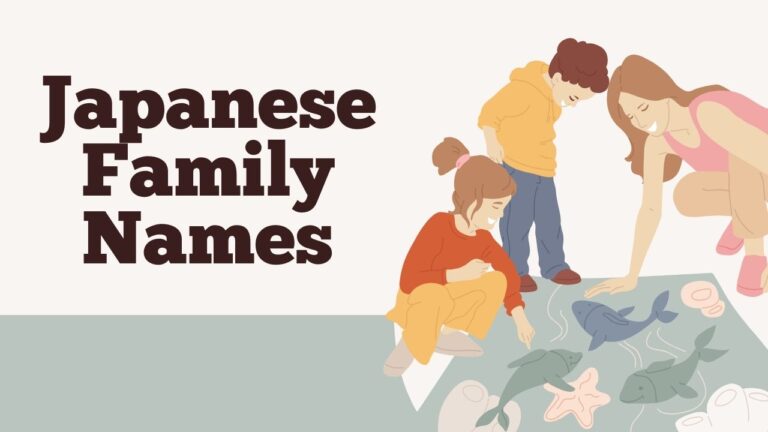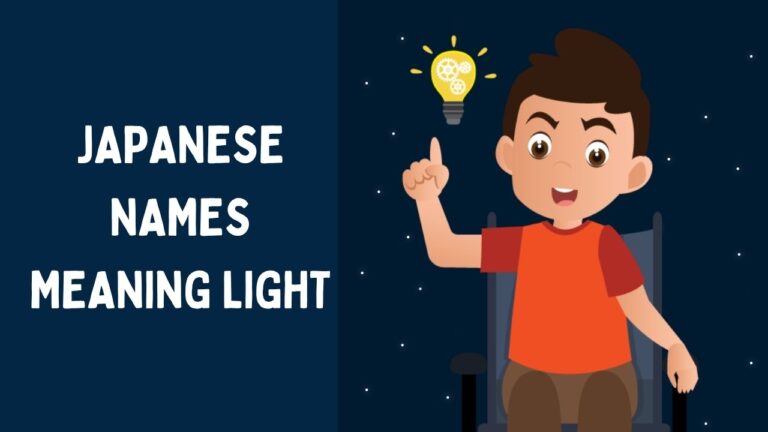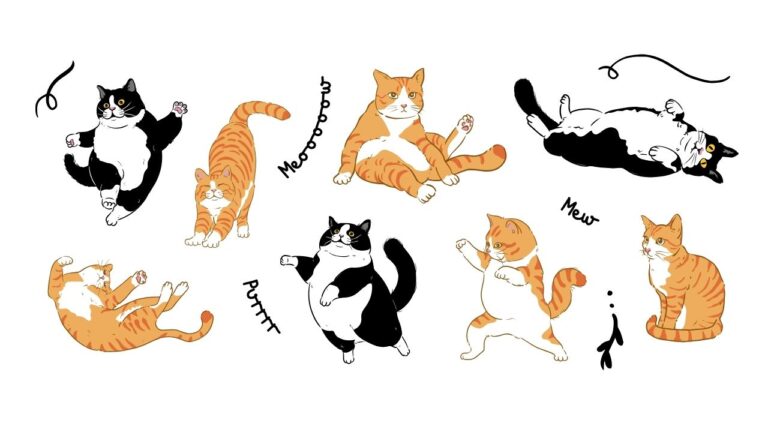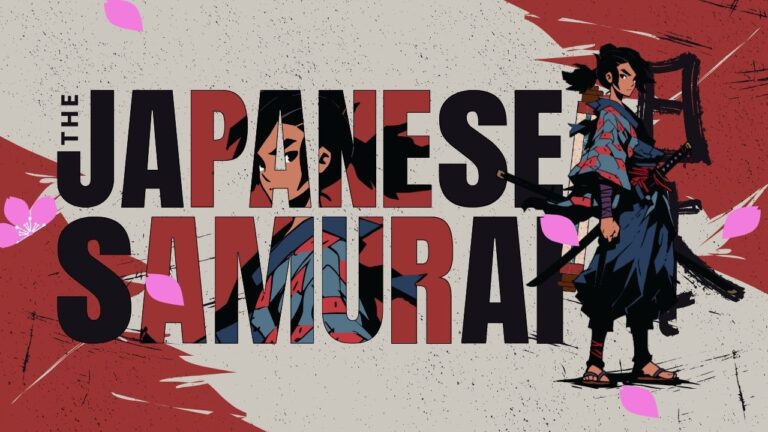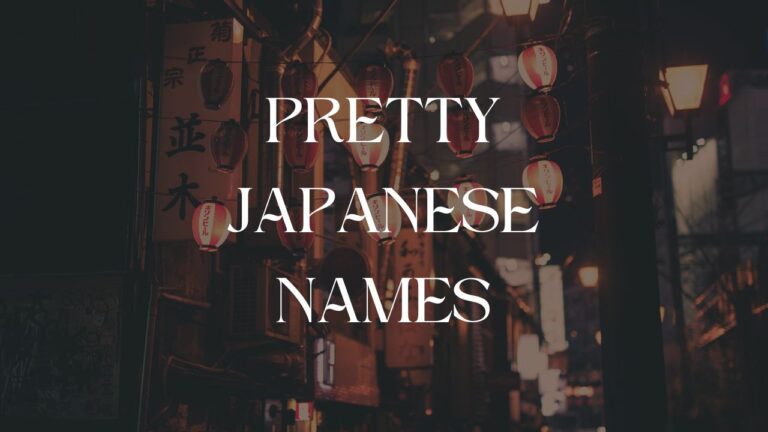130+ Japanese Names That Mean Flower – Beautiful Floral Meanings
Japanese names that mean flower carry deep cultural beauty, symbolizing nature, elegance, and emotion. Whether you’re looking for Japanese names that mean flower girl or Japanese names that mean flower male, these names often reflect the delicate balance found in Japanese aesthetics.
From the soft grace of Japanese girl names meaning cherry blossom to the rare intrigue of Japanese names that mean poisonous flower, each name holds a unique story.
Many parents also search for Japanese girl names meaning beautiful, combining charm and floral symbolism to choose names that truly bloom with meaning.
Also Read:115+ Japanese names meaning star
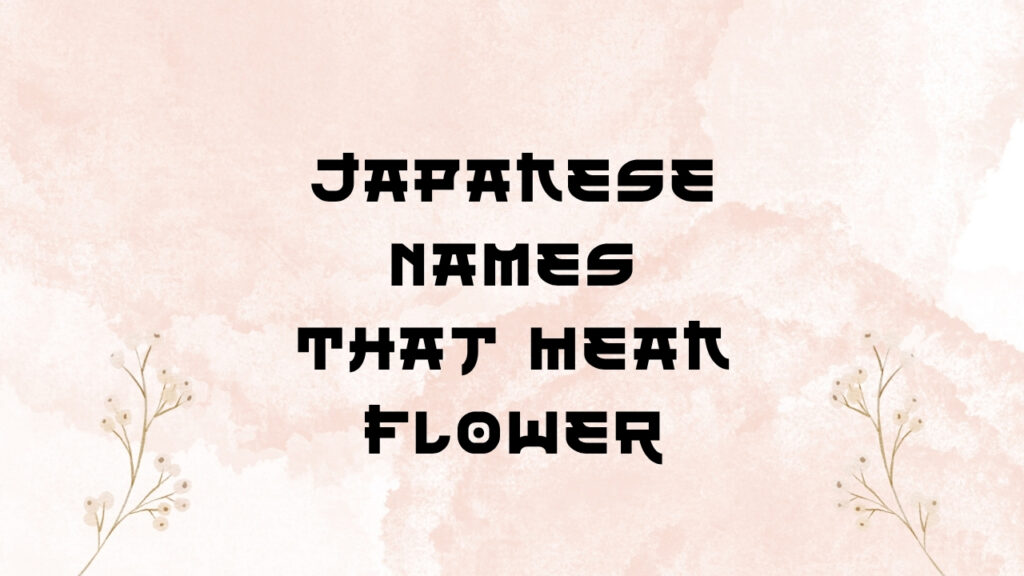
Unisex Japanese Names That Mean Flower
- Hana (花) – Means “flower”; one of the most common and simple names in Japan, suitable for any gender.
- Kaede (楓) – Means “maple leaf”; symbolic of autumn and gentle transformation.
- Sumire (菫) – Refers to “violet flower”; associated with loyalty and modesty.
- Ren (蓮) – Means “lotus”; a unisex name tied to purity and spiritual awakening.
- Sakura (桜) – Refers to “cherry blossom”; symbolizes the fleeting beauty of life.
- Botan (牡丹) – Means “peony”; represents bravery and honor, traditionally gender-neutral.
- Ayame (菖蒲) – Refers to the “iris flower”; symbolizes strength and resilience.
- Hinagiku (雛菊) – Means “daisy”; often represents innocence and cheerfulness.
- Tsubaki (椿) – Means “camellia”; symbolizes admiration and perfection.
- Kiku (菊) – Refers to the “chrysanthemum”; a symbol of longevity and rejuvenation.
- Shion (紫苑) – Refers to “aster flower”; often represents remembrance.
- Ume (梅) – Means “plum blossom”; stands for perseverance and beauty in adversity.
- Fuji (藤) – Means “wisteria”; associated with elegance and grace.
- Yuri (百合) – Means “lily”; symbolizes purity and refined beauty.
- Tsutsuji (躑躅) – Means “azalea”; a rare flower name used in poetic references.
- Asagao (朝顔) – Means “morning glory”; signifies brief but vibrant life.
- Momo (桃) – Refers to “peach blossom”; also linked to love and femininity but unisex in tone.
- Kikyo (桔梗) – Refers to the “bellflower”; symbolizes honesty and unchanging love.
- Suisen (水仙) – Means “daffodil”; associated with grace and self-respect.
- Nadeshiko (撫子) – A name from the phrase “Yamato Nadeshiko,” meaning the ideal beauty, but also refers to a type of pink flower.
- Tachibana (橘) – Refers to a citrus flower, often used as a surname but suitable as a given name.
- Obana (尾花) – Means “tail flower” (silver grass); has seasonal and poetic associations.
- Shirayuri (白百合) – Means “white lily”; unisex and symbolizing innocence.
- Himawari (向日葵) – Means “sunflower”; represents loyalty and warmth.
- Kosumosu (秋桜) – Means “cosmos flower”; carries meanings of harmony and peace.
Japanese Girl Names That Mean Flower
- Haruka (陽花 / 春花) – “Spring flower” or “sunny flower”; reflects warmth and brightness.
- Nanohana (菜の花) – Refers to “canola flower”; symbolizes fresh beginnings and cheer.
- Koharu (小春 / 小晴) – “Little spring” or “early spring sunshine,” often associated with seasonal flowers blooming early.
- Mizuki (瑞希 / 美月) – Can mean “beautiful flower” or “fresh hope”; often linked to floral elegance.
- Ichika (一花) – “One flower”; a poetic and minimalist name symbolizing uniqueness.
- Honoka (穂花) – “Spikelet flower” or “blossoming grain”; represents grace and natural beauty.
- Manaka (真花) – “True flower”; denotes authenticity and natural charm.
- Sayaka (沙耶花 / さやか) – “Clear and blooming flower”; evokes purity and clarity.
- Himari (陽葵) – Combines “sun” and “sunflower”; represents warmth and energy.
- Rinka (凛花) – “Dignified flower”; symbolizes strength with grace.
- Nozomi (望美 / 希美) – While often meaning “hope,” some versions include 花 to represent a hopeful flower.
- Yumehana (夢花) – “Dream flower”; poetic and filled with imagination.
- Aohana (蒼花) – “Blue flower”; a unique name symbolizing calmness and tranquility.
- Hinahana (陽菜花) – A variation incorporating sun and vegetables with flowers, symbolizing life and abundance.
- Mihana (美花) – “Beautiful flower”; a gentle, elegant name with feminine charm.
- Haruna (春菜 / 春奈) – Includes “spring” and often evokes the image of blossoming flowers.
- Ririka (莉里花) – A stylish and modern name with multiple flower kanji, including jasmine.
- Yuka (優花 / 由花) – “Gentle flower” or “reason flower”; reflects softness and kindness.
- Ayaka (彩花 / 綾花) – “Colorful flower”; signifies vividness and artistic beauty.
- Kanae (花苗) – “Flower seedling”; represents new life, growth, and hope.
- Misaki (美咲) – “Beautiful bloom”; widely used and admired for its soft sound and meaning.
- Sena (世奈 / 瀬菜) – Includes “na” from 菜 (greens/flowers), evoking a fresh, natural feeling.
- Sakurae (桜恵) – “Blessing of cherry blossoms”; connects floral beauty with grace.
- Tomohana (朋花) – “Friendly flower”; evokes harmony and compassion.
- Mahana (真花菜) – A combination name meaning “true flower greens”; modern, fresh, and earthy.
Japanese Boy Names That Mean Flower
- Haruki (陽葵 / 春輝) – “Spring radiance” or “sunflower radiance”; combines energy and blooming life.
- Takahana (貴花) – “Noble flower”; conveys dignity and refined beauty.
- Masaki (真咲) – “True blossom”; expresses purity and truth through nature.
- Kaito (海翔 / 海桐) – Can be written with 桐 (paulownia flower); symbolizes strength and uniqueness.
- Hinata (日向 / 陽向) – “Sunny place”; often associated with flowers thriving in the sun.
- Reikao (麗花生) – A modern, rare name meaning “beautiful blooming life.”
- Shunka (俊花) – “Talented flower”; used poetically to describe brilliance in youth.
- Taika (大花) – “Great flower”; evokes pride, bloom, and future success.
- Renjiro (蓮次郎) – “Lotus second son”; lotus signifies spiritual purity and resilience.
- Kanon (花音) – “Flower sound”; gender-neutral but often used for boys with artistic tone.
- Aoiro (葵朗) – Combines “hollyhock” and “bright”; elegant and rare for boys.
- Yoshika (善花) – “Virtuous flower”; blends kindness and natural grace.
- Naoto (尚翔 / 尚花) – Depending on kanji, can include “flower” with noble meaning.
- Souta (蒼太 / 蒼花) – Includes 蒼 (“blue/green”) and 花 (“flower”); fresh and strong.
- Takahana (高花) – “Tall flower”; symbolic of standing out with pride.
- Kakeru (翔花 / 翔華) – “Flying flower” or “soaring blossom”; poetic and energetic.
- Rento (蓮翔) – “Lotus flight”; gentle and grounded with spiritual tones.
- Hinaki (陽花樹) – “Sun-flower-tree”; a nature-rich and layered boy’s name.
- Kazahana (風花) – “Wind flower” or “snow flower”; used in poetic contexts, suitable for boys.
- Reiji (礼慈 / 麗慈) – Can be written with floral or graceful characters; means “graceful compassion.”
- Aratahana (新花) – “New flower”; perfect for symbolizing new beginnings and hope.
- Tsubasa (翼花) – “Winged flower”; expressive, free-spirited, and artistic.
- Kaika (開花) – Means “to bloom”; metaphorically tied to growth and youth.
- Soraki (空葵) – “Sky hollyhock”; poetic, airy, and nature-themed.
- Michihana (道花) – “Flower of the path”; symbolizes a blooming journey in life.
Unique Japanese Names That Mean Flower
- Hanayu (花結) – “Flower tie” or “flower connection”; symbolizes bonds and unity.
- Kazahana (風花) – “Wind flower” or “snow-blossom”; a poetic term for snow drifting like petals.
- Suhana (澄花) – “Clear flower”; represents purity and clarity in spirit.
- Mahana (真花奈) – “True flower of Nara”; regional and authentic in tone.
- Hanamei (花芽依) – “Flower bud with blessing”; youthful and hopeful.
- Rinbana (凛花那) – “Dignified flower”; graceful, with a strong presence.
- Yohana (陽花音) – “Sun, flower, and sound”; vibrant, melodic, and bright.
- Hanashiro (花城) – “Flower castle”; noble and majestic, yet gentle.
- Hanakae (花映) – “Flower reflection”; a poetic image of blossoms mirrored in water.
- Ayahana (彩花奈) – “Colorful flower of Nara”; joyful and expressive.
- Tobana (翔花) – “Flying flower”; symbolizes freedom, motion, and grace.
- Hanayo (花代) – “Generational flower”; often tied to heritage and legacy.
- Reihana (麗花奈) – “Graceful flower of Nara”; elegant and regionally inspired.
- Hanagiku (花菊) – “Flower chrysanthemum”; chrysanthemum is a noble flower in Japan.
- Hanazuki (花月希) – “Flower moon hope”; dreamy and symbolic of beauty and hope.
- Mihanae (美花依) – “Beautiful flower that leans (on someone)”; gentle and nurturing.
- Shihana (紫花奈) – “Purple flower of Nara”; mysterious and graceful.
- Hinahanae (陽菜花依) – “Sun greens and flower blessing”; full of natural life.
- Hanaria (花莉愛) – “Jasmine love flower”; romantic and fragrant.
- Hanata (花汰) – “Flower abundance”; rare and filled with vitality.
- Eihana (永花) – “Eternal flower”; signifies lasting beauty and love.
- Sakihana (咲花奈) – “Blossoming flower of Nara”; joyful and seasonal.
- Hanari (花里) – “Flower village”; tranquil and nature-centered.
- Mikahana (美華花) – “Beautiful, elegant flower”; refined and regal.
- Yurihana (百合花) – “Lily flower”; delicate, elegant, and unique in combination.
Japanese Names That Mean Pink Flower
- Momoka (桃花) – “Peach flower”; represents sweetness, innocence, and love.
- Sakino (咲乃) – “Blossom child”; evokes the image of a pink flower blooming in spring.
- Kosora (小空桜) – “Little sky cherry blossom”; poetic and dreamy.
- Momone (桃音) – “Sound of peach”; soft and gentle, symbolizing warmth and calm.
- Haruzakura (春桜) – “Spring cherry blossom”; evokes fresh pink blooms in early spring.
- Sakurana (桜菜) – “Cherry blossom and greens”; a fresh, nature-inspired name.
- Hozakura (穂桜) – “Spike cherry blossom”; blends floral beauty with harvest imagery.
- Momomi (桃美) – “Beautiful peach”; expresses soft beauty and femininity.
- Benika (紅花) – “Crimson flower” (safflower); historically used to dye pink-red cloth.
- Ichizakura (一桜) – “One cherry blossom”; symbolizing uniqueness and elegance.
- Sanae (早苗 / 咲苗) – “Blooming seedling”; associated with early blossoming flowers.
- Rengeka (蓮華花) – “Lotus blossom flower”; lotus often appears pink in Japanese culture.
- Sakurako (桜子) – “Child of cherry blossom”; a timeless, elegant girl’s name.
- Benihana (紅花菜) – “Pink flower greens”; a name rooted in natural simplicity.
- Kokona (心菜 / 心花) – “Heart flower”; evokes inner beauty and gentle affection.
- Sakuri (咲莉) – “Blossoming jasmine”; delicate and often linked to soft pink tones.
- Momohana (百桃花) – “Hundred peach flowers”; poetic and full of life.
- Sakurae (桜映) – “Reflecting cherry blossom”; graceful and lyrical.
- Benizakura (紅桜) – “Crimson cherry blossom”; a deeper pink variant of sakura.
- Sumomo (李 / 酢桃) – “Japanese pink plum”; small and charming like a flower.
- Hinoka (陽乃花) – “Sun’s flower”; often associated with camellias and cherry blossoms.
- Akarihana (明花里) – “Bright village flower”; radiant and tender, with a springtime feel.
- Yuyuka (優優花) – “Gentle gentle flower”; soft, rhythmic, and pastel-toned in sound.
- Hanari (花梨) – “Flower quince”; the quince blossom has a subtle pink hue.
- Sakuranae (桜苗) – “Cherry blossom sprout”; symbolizes new life and delicate beginnings.
Japanese Names That Mean Red Flower
- Akahana (赤花) – “Red flower”; a simple and direct name symbolizing passion and vitality.
- Tsubaki (椿) – A deep red camellia flower; symbolizes admiration and perfection.
- Benika (紅香) – “Crimson fragrance”; evokes the rich scent of blooming red flowers.
- Hinabana (陽花菜) – “Sunny red flower greens”; warm, vibrant, and life-filled.
- Kurenai (紅) – “Deep crimson”; traditionally used in poetry to refer to red blossoms.
- Benihana (紅花) – “Safflower”; used in red dye, symbolizing strength and hidden softness.
- Koume (紅梅) – “Red plum blossom”; blooms in late winter, representing perseverance and passion.
- Hiiragi (柊赤) – Though normally meaning holly, paired with “aka” can mean “red holly flower.”
- Himaka (陽真花) – “True red sun-flower”; radiant and grounded.
- Higana (緋花) – “Scarlet flower”; bold and emotional.
- Reenka (麗紅花) – “Graceful crimson flower”; refined and passionate.
- Akané (茜) – “Madder red” plant, traditionally used for red dye; poetic and rich.
- Shuka (朱花) – “Vermilion flower”; intense and symbolic of fiery emotions.
- Enka (炎花) – “Flame flower”; rare and symbolizing intense love or ambition.
- Akae (赤映) – “Reflected red”; like red petals shimmering in water.
- Benitsuki (紅月) – “Crimson moon”; though not a literal flower, often used as metaphor for red blossoms under the moonlight.
- Akarihana (灯花) – “Light flower”; the small flame-like flowers on traditional candles, symbolically red.
- Higanbana (彼岸花) – “Red spider lily”; mysterious and tied to partings and the afterlife.
- Akaneiro (茜色) – “Madder red color”; poetic name inspired by flower dyes.
- Kokihi (恋緋) – “Love scarlet”; soft and romantic.
- Benihanae (紅花依) – “Crimson flower blessing”; vibrant and elegant.
- Shouka (焼花) – “Burning flower”; evokes a fierce and passionate bloom.
- Hanabeni (花紅) – “Flower red”; a beautiful reversal of traditional “benihana.”
- Beniri (紅梨) – “Crimson pear blossom”; a stylized and rare combination.
- Akazakura (赤桜) – “Red cherry blossom”; a dramatic and rare variation of the usual pale sakura.
Japanese Names That Mean Blue Flower
- Aohana (青花) – “Blue flower”; simple and elegant, directly reflects its meaning.
- Rindou (竜胆) – “Gentian flower”; a deep blue bloom symbolizing sincerity and justice.
- Aokusa (青草) – “Blue grass”; metaphorically represents bluish flower fields.
- Aokari (青花梨) – “Blue flower quince”; rare and lyrical, combining two natural elements.
- Sokihana (蒼希花) – “Wishing blue flower”; poetic and filled with hope.
- Aosumi (青澄) – “Clear blue”; refers to flower water or skies reflecting blue tones.
- Hanairo (花藍) – “Indigo flower”; associated with traditional Japanese dyeing and deep blue hues.
- Aoyuri (青百合) – “Blue lily”; lilies are rarely blue, so this name suggests rarity and elegance.
- Sorahana (空花) – “Sky flower”; suggests a soft blue bloom, like sky-colored petals.
- Seika (青華) – “Blue blossom”; refined and often used in artistic or poetic contexts.
- Aona (青菜花) – “Blue greens flower”; a nature-infused, earthy floral name.
- Aoame (青雨花) – “Blue rain flower”; dreamy and poetic, like flowers blooming in gentle rain.
- Aosaka (青咲) – “Blue bloom”; a fresh, seasonal name symbolizing calm beginnings.
- Aoruri (青瑠璃) – “Blue lapis flower”; combines flower beauty with gemstone-like brilliance.
- Aoemi (蒼恵美) – “Graceful blessing in blue”; elegant and meaningful.
- Aohanae (青花依) – “Blue flower blessing”; ties nature with affection and grace.
- Hanasae (花冴) – “Chilled flower”; not directly blue, but often used for bluish or cool-blooming flowers.
- Kisaohana (蒼花菜) – “Blue flower greens”; fresh, rare, and nature-rooted.
- Aoikusae (葵草映) – “Blue hollyhock grass reflection”; deeply poetic and traditional.
- Rurika (瑠璃花) – “Lapis lazuli flower”; precious, exotic, and glowing blue.
- Aonozomi (青望) – “Blue hope”; not a flower literally, but suggests a blue-flower-like calm wish.
- Aoaya (青彩) – “Blue color bloom”; emphasizes brightness and vividness in flowers.
- Aoazami (青薊) – “Blue thistle”; rare and wildflower-like in tone.
- Sokari (蒼花梨) – “Deep blue flower pear”; a combination name evoking rare beauty.
- Aobanae (青花苗) – “Blue flower sprout”; symbolizes a fresh start with peaceful tones.
Japanese Names That Mean Poisonous Flower
- Dokumi (毒実) – “Poison fruit”; used metaphorically for alluring yet dangerous beauty.
- Hanadoku (花毒) – “Flower poison”; poetic and intense, combining beauty with threat.
- Shidoku (死毒) – “Deadly poison”; a dark name symbolizing fatal attraction.
- Rengezaki (蓮華咲) – “Blooming lotus,” often symbolizing spiritual mystery, but here with toxic associations.
- Torika (鳥花 / 鳥兜花) – “Aconite flower” (monkshood); a deadly, beautiful purple bloom.
- Dokuha (毒華) – “Poisonous flower” with a literary and elegant tone.
- Yurisha (百合邪) – “Corrupted lily”; suggests a beautiful flower with dark implications.
- Kurohana (黒花) – “Black flower”; commonly tied to forbidden or toxic beauty.
- Uragiku (裏菊) – “Hidden chrysanthemum”; can hint at poisonous secrets or inner darkness.
- Higan (彼岸) – Refers to the “other shore,” also tied to the deadly higanbana flower.
- Dokuyami (毒闇) – “Poison darkness”; powerful and mysterious, like a toxic night bloom.
- Shizuka (静華) – “Silent flower”; when paired with toxic themes, can imply deadly quiet.
- Karisuna (枯砂花) – “Withered sand flower”; eerie and dry, symbolizing decay and danger.
- Dokubana (毒花) – “Toxic flower”; direct, intense, and often symbolic in dark fiction.
- Amanome (天毒芽) – “Heavenly poison sprout”; elegant and ironic.
- Dokuume (毒梅) – “Poison plum”; refers to a seemingly sweet but dangerous blossom.
- Yamiuri (闇百合) – “Dark lily”; sensual and dangerous.
- Shinsouka (深葬花) – “Deep burial flower”; tied to themes of death and poisonous farewell.
- Dokumon (毒門) – “Gate of poison”; metaphorical for entry into danger.
- Tsuyadoku (艶毒) – “Lustful poison”; reflects beauty that hides danger.
- Gekika (劇花) – “Intense flower”; tied to violent poison or strong emotional effect.
- Dokunasu (毒茄子) – “Poison eggplant”; actually a type of toxic nightshade.
- Yuzurika (柚毒花) – “Citrus poison flower”; unique and aromatic, yet deadly.
- Kagerouka (陽炎花) – “Heat-haze flower”; illusory beauty, often used as a symbol for deceptive or toxic love.
- Mayokusa (迷草) – “Bewitching plant”; not directly a flower, but associated with hallucinations and poison.
Japanese Names That Mean Yellow Flower
- Kihana (黄花) – “Yellow flower”; directly expresses brightness and positivity.
- Nanami (菜美) – “Beautiful canola”; inspired by nanohana, a bright yellow flower of spring.
- Yamabuki (山吹) – A classic name referring to the kerria japonica; a golden-yellow bloom symbolizing elegance and prosperity.
- Kinuka (金花) – “Golden flower”; radiant and warm in meaning.
- Kinari (金莉) – “Golden jasmine”; elegant, exotic, and softly fragrant.
- Hinana (陽菜奈) – Incorporates “sun” and “greens,” hinting at sunny yellow blossoms.
- Kikusa (黄草) – “Yellow grass/plant”; earthy and floral, symbolic of seasonal life.
- Ougiku (黄菊) – “Yellow chrysanthemum”; associated with autumn and longevity.
- Kiyoka (清花 / 黄陽花) – “Pure flower” or “yellow sun-flower,” depending on kanji; fresh and bright.
- Kanae (香菜恵) – “Fragrant greens blessing”; tied to blooming yellow herbs.
- Hinabuki (陽吹) – “Sun-blown”; poetic and evokes the gentle breeze through yellow petals.
- Yukika (幸黄花) – “Fortunate yellow flower”; symbolic of joy and luck.
- Kinariha (金花葉) – “Golden flower leaf”; suggests full-blooming trees or bushes in yellow.
- Kanonari (花乃成) – “Flower of success”; often linked to gold/yellow floral imagery.
- Kikahanae (黄花依) – “Yellow flower blessing”; gentle and natural in tone.
- Mikina (美黄菜) – “Beautiful yellow greens”; cheerful and spring-like.
- Kohina (小陽菜) – “Little sunny greens”; light, warm, and floral in essence.
- Kibanae (黄花苗) – “Yellow flower sprout”; fresh and full of life.
- Hinaki (陽菜黄) – “Sunny yellow greens”; a unique color-focused variation.
- Kisouka (黄爽花) – “Bright yellow flower”; refreshing and cheerful.
- Harukina (春黄菜) – “Spring yellow greens”; seasonal and full of bloom.
- Kinako (金杏子) – “Golden apricot”; a tree with small yellow blossoms.
- Kihanari (黄花成) – “Yellow flower success”; symbolic of growth and fortune.
- Kogiku (小菊) – “Little chrysanthemum”; can refer to soft yellow miniature blooms.
- Kinazusa (金葵) – “Golden hollyhock”; noble and radiant, tied to Japanese imperial imagery.
conclusion
Japanese names inspired by flowers offer more than just beauty—they carry deep cultural meanings, seasonal references, and poetic symbolism.
Whether reflecting the warmth of yellow blooms, the rarity of blue petals, or the mysterious allure of poisonous flowers, these names connect nature with identity in thoughtful and expressive ways.
Choosing a floral name in Japanese isn’t just about aesthetics; it’s a way to honor tradition, emotion, and the quiet power of nature woven into everyday life.

